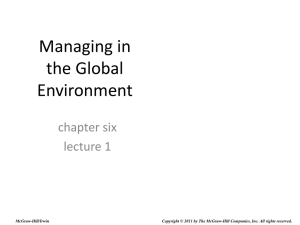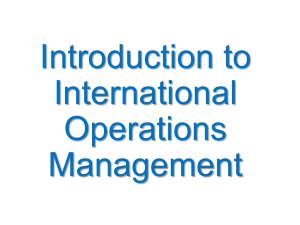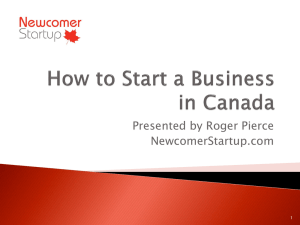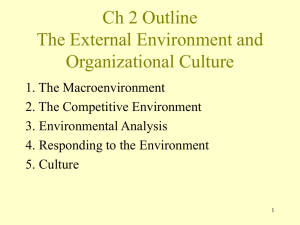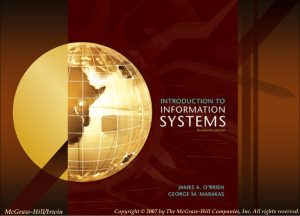Your Question! - Information Technology
advertisement
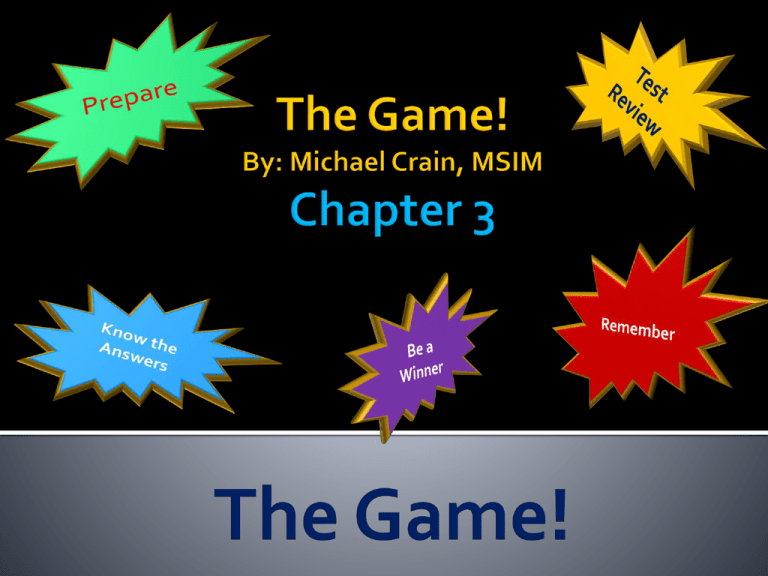
Each person will be ask to “pick a number” from the “Game Board” linking to a specific question about what was presented in the Book. Each of these questions are worth “points” and will be displayed when a question is “correctly answered” Each player will have the opportunity to “PLAY” the question or “PASS” the question to a person within the class. Questions can only be passed once! A1 B1 C1 D1 E1 F1 G1 H1 I1 A2 B2 C2 D2 E2 F2 G2 H2 I2 A3 B3 C3 D3 E3 F3 G3 H3 I3 A4 B4 C4 D4 E4 F4 G4 H4 I4 A5 B5 C5 D5 E5 F5 G5 H5 I5 A6 B6 C6 D6 E6 F6 G6 H6 I6 A7 B7 C7 D7 E7 F7 G7 H7 I7 A8 B8 C8 D8 E8 F8 G8 H8 I8 The Game Board! A. B. A firm can be said to have competitive advantage when it has higher stock market valuations than its competitors. TRUE FALSE A. B. The competitive forces model was created for today's digital firm. TRUE FALSE A. B. Customers are one of the competitive forces that affect an organization's ability to compete. TRUE FALSE A. B. A transparent marketplace means that there is high product differentiation. TRUE FALSE A. B. Studies show that about half of a business firm's profits can be explained by alignment of IT with business. TRUE FALSE A. B. In an efficient customer response system, digital answering systems are used to monitor and respond to customer inquiries. TRUE FALSE A. B. In the strategy of product differentiation, information systems are used to enable new products and services. TRUE FALSE A. B. Mass customization requires different production resources from mass production. TRUE FALSE A. B. Strong linkages to customers and suppliers increase switching costs. TRUE FALSE A. B. The effect of the Internet has been to raise bargaining power over suppliers. TRUE FALSE A. B. In the age of the Internet, Porter's traditional competitive forces model is still at work, but competitive rivalry has become much more intense. TRUE FALSE A. B. In the value chain model, primary activities are most directly related to the production and distribution of the firm's products and services that create value for the customer. TRUE FALSE A. B. C. D. Which of the following is not one of the competitive forces of Porter's model? Suppliers Other competitors External environment Customers. A. B. C. D. A manufacturer of deep-sea oil rigs may be least concerned about which of these marketplace forces? Product differentiation Traditional competitors Low number of suppliers New market entrants A. B. C. D. Which of the following industries has the lowest barrier to entry? Automotive Computer-chip Restaurant Airline A. B. C. D. A substitute product of most concern for a cable TV distributor is: satellite TV. broadcast TV. satellite radio. the Internet. A. B. C. D. Which of the following can force a business and its competitors to compete on price alone? High product differentiation Poor process efficiency Demand control Transparent marketplace A. B. C. D. A firm can exercise greater control over its suppliers by having: more suppliers. fewer suppliers. global suppliers. local suppliers. A. B. C. D. Wal-Mart's continuous replenishment system allows it to: provide mass customization. provide an efficient customer response system. strengthen customer intimacy. achieve economy of scale. A. B. C. D. When a firm provides a specialized product or service for a narrow target market better than competitors, they are using a: product differentiation strategy. market niche strategy. mass customization strategy. process efficiency strategy. A. B. C. D. ________ is the ability to offer individually tailored products or services using the same production resources as bulk production. Mass customization Size customization Personalization Demand customization A. B. C. D. An information system can enable a company to focus on a market niche through: complex trend forecasting. tailoring products to the client. intensive product trend analysis. intensive customer data analysis. A. B. C. D. Hilton Hotels' use of customer information software to identify the most profitable customers to direct services to is an example of using information systems to: strengthen customer intimacy. differentiate their service. focus on market niche. increase efficiency. A. B. C. D. Which industries did the first wave of ecommerce transform? Air travel, books, bill payments Air travel, books, music Real estate, air travel, books Real estate, books, bill payments A. B. C. D. To what competitive force did the printed encyclopedia industry succumb? Positioning and rivalry among competitors Low cost of entry Substitute products or services Customer's bargaining power Internet technology: makes it easy for rivals to compete on price alone. imposes a significant cost of entry, due to infrastructure requirements. C. increases the difference between competitors because of the wide availability of information. D. makes it easy to sustain operational advantages. A. B. The Internet raises the bargaining power of customers by: creating new opportunities for building loyal customer bases. B. making more products available. C. making information available to everyone. D. lowering transaction costs. A. A. B. C. D. The value chain model: categorizes five related advantages for adding value to a firm's products or services. sees the supply chain as the primary activity for adding value. categorizes four basic strategies a firm can use to enhance its value chain. helps a firm identify points at which information technology can most effectively to enhance its competitive position. The primary activities of a firm include: inbound logistics, operations, outbound logistics, sales and marketing, and service. B. inbound logistics, operations, outbound logistics, technology, and service. C. procurement, inbound logistics, operations, technology, and outbound logistics. D. procurement, operations, technology, sales and marketing, and service. A. A. B. C. D. The most successful solutions or methods for achieving a business objective are called: core processes. best processes. benchmarks. best practices. A firm's value chain is linked to the: value webs of its industry. value chains of its suppliers, distributors, and customers. C. value webs of its suppliers and distributors. D. value chains of its suppliers and customers. A. B. A. B. C. D. ) A ________ is a collection of independent firms that use information technology to coordinate their value chains to produce a product or service for a market collectively. value chain business network value web consortia How are information systems used at the industry level to achieve strategic advantage? By building industry-wide, IT-supported consortia and symposia B. By raising the bargaining power of suppliers C. By encouraging the entry of new competitors D. By enforcing standards that reduce the differences between competitors A. An information system can enhance core competencies by: providing better reporting facilities. creating educational opportunities for management. allowing operational employees to interact with management. D. encouraging the sharing of knowledge across business units. A. B. C. A. B. C. D. The more any given resource is applied to production, the lower the marginal gain in output, until a point is reached where the additional inputs produce no additional output is referred to as: the point of no return. the law of diminishing returns. supply and demand. Inelasticity. You have no Question as You are an instant winner of And you think - you got it easy! “2 Points” You have no Question as You are an instant winner of “4 Points” WOW, That was close! You have no Question You are an instant WINNER of “6 Points” WAKE ME UP LATER! You are an instant WINNER Select a Team and GIVE them the Gift of Points You get to have another question! “8 Points” WOW! What a NICE Team! You have no Question You are an instant WINNER of Take the points and Relax! Network economics: applies the law of diminishing returns to communities of users. B. applies traditional economics to networked users. C. sees the cost of adding new members as inconsequential. D. balances the high cost of adding new members to a community against the lower cost of using network infrastructure. A. A. B. C. D. In network economics, the value of a commercial software vendor's software products: increases as more people use them. decreases as more people use them. increases due to higher marginal gain in output. decreases according to the law of diminishing returns. A virtual company: uses the capabilities of other companies without being physically tied to those companies. B. uses Internet technology to maintain a virtual storefront. C. uses Internet technology to maintain a networked community of users. D. provides entirely Internet-driven services, or virtual products. A. Globalization allows: information systems to enhance core competencies. B. businesses to sell their products on a global scale. C. businesses to use the capabilities of other companies without being physically tied to those companies. D. information systems to more fully utilize Internet capabilities. A. A. B. C. D. The greatest impact the Internet has had on globalization is in lowering the costs of: labor. telecommunications. network infrastructure. entry to global-scale operations. A. B. C. D. The ________ strategy concentrates financial management and control out of a central home base while decentralizing production, sales, and marketing operations to units in other countries. domestic exporter multinational franchise transnational A. B. C. D. The ________ strategy is characterized by heavy centralization of corporate activities in the home country of origin. domestic exporter multinational franchise transnational A. B. C. D. ________ systems are those in which each foreign unit designs its own unique information system solutions. Centralized Decentralized Duplicated Networked A. B. C. D. ________ systems are those in which development occurs at the home base but operations are handed over to autonomous units in foreign locations. Centralized Decentralized Duplicated Networked A. B. C. D. ________ systems are those in which systems development and operation occur totally at the domestic home base. Centralized Decentralized Duplicated Networked A. B. C. D. ________ typically develop a single information system, usually at the home base, and then replicate it around the world. Domestic exporters Multinational firms Franchisers Transnational firms A. B. C. D. Seeing quality as the responsibility of all people and functions in an organization is central to the concept of: Six sigma. TQM. quality control. cycle time reduction. A. B. C. D. Which of the following is not a benefit of implementing CAD systems? Reducing the time spent on completing a design Reducing the time spent on benchmarking Ability to review designs for errors prior to production Ability to make changes to digital models without building physical prototypes A. B. C. D. Streamlining the steps taken to complete a business task more efficiently is called: workflow reengineering. business process management. business process reengineering. workflow management. Many reengineering projects do not achieve breakthrough gains in performance because: A. B. organizational change is difficult to manage. it is difficult to streamline many business processes. workflow management is difficult to achieve. document management is difficult to achieve. C. D. Benchmarking: compares the efficiency and effectiveness of your business processes against strict standards. B. allows industry participants to develop industrywide standards. C. is used to measure the speed and responsiveness of information technology. D. synchronizes the business processes of customers, suppliers, and trading partners. A. A. B. Business process reengineering is the radical redesign of business processes. TRUE FALSE A. B. The more people that use Microsoft Office software and related products, the greater its value. TRUE FALSE A. B. The value chain model classifies all company activities as either primary or support. TRUE FALSE YOU RECEIVE NO POINTS I got my eye on you! YOU RECEIVE NO POINTS What do you mean! YOU RECEIVE NO POINTS WAIT! I know the ANSWER! Your Answer is correct! Total Points 10 You Win! Your Answer is correct! Total Points 15 Your Answer is correct! Total Points You want on our team! 20 YOU ARE a Winner!!! Your Kidding! RIGHT! You Received 25 Points


